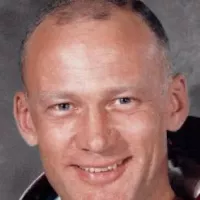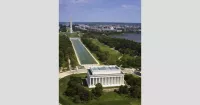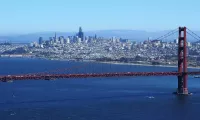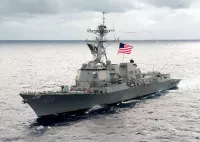From career breakthroughs to professional milestones, explore how Jim Lovell made an impact.
James "Jim" Lovell is a retired American astronaut, naval aviator, and mechanical engineer. He is renowned for his pivotal role in space exploration, notably as the command module pilot of Apollo 8 in 1968, making him one of the first humans to orbit the Moon alongside Frank Borman and William Anders. Lovell is most famously known for commanding the ill-fated Apollo 13 mission in 1970. Despite a critical equipment failure during the mission, Lovell and his crew successfully navigated their spacecraft around the Moon and safely returned to Earth. Beyond his astronautical achievements, Lovell has also made minor appearances in films.
1952: Graduation from the United States Naval Academy
In 1952, James Lovell graduated from the United States Naval Academy in Annapolis, Maryland, and subsequently flew F2H Banshee night fighters, being deployed in the Western Pacific aboard the aircraft carrier USS Shangri-La.
1952: Graduation and Marriage
In 1952, James Lovell graduated with a Bachelor of Science degree and was commissioned as an ensign in the Navy. On June 6, 1952, he married Marilyn Lillie Gerlach.
February 1, 1954: Designated a Naval Aviator
On February 1, 1954, James Lovell was designated a naval aviator upon completion of pilot training.
February 1954: Assigned to VC-3 at Moffett Field
In February 1954, James Lovell was assigned to VC-3 at Moffett Field near San Francisco, California.
1956: Reassigned to provide pilot transition training
In 1956, upon returning to shore duty, James Lovell was reassigned to provide pilot transition training for the North American FJ-4 Fury, McDonnell F3H Demon and Vought F8U Crusader.
January 1958: Test Pilot Training
In January 1958, James Lovell entered a six-month test pilot training course at the Naval Air Test Center at Naval Air Station Patuxent River, Maryland, graduating at the top of his class.
1960: McDonnell Douglas F-4 Phantom II program manager
In 1960, James Lovell became the McDonnell Douglas F-4 Phantom II program manager.
1960: F-4 Phantom II program manager
In 1960, James Lovell became the Navy's McDonnell Douglas F-4 Phantom II program manager.
1961: Flight instructor and safety engineering officer
In 1961, James Lovell became a flight instructor and safety engineering officer at Naval Air Station Oceana in Virginia Beach, Virginia, and completed Aviation Safety School at the University of Southern California.
September 1962: Accepted into NASA's second group of astronauts
In September 1962, James Lovell was accepted into NASA as one of the second group of astronauts for the Gemini and Apollo programs, after initially being rejected as one of the Mercury Seven astronauts due to a temporarily high bilirubin count.
July 29, 1964: Selected as backup pilot for Gemini 4
On July 29, 1964, James Lovell was selected as backup pilot for Gemini 4, positioning him for his first space flight three missions later.
July 1, 1965: Selection for Gemini 7 mission announced
On July 1, 1965, James Lovell and Frank Borman were officially announced as the crew for the Gemini 7 mission, with Edward White and Michael Collins as their backup crew.
December 4, 1965: Gemini 7 Liftoff
On December 4, 1965, Gemini 7, carrying James Lovell and Frank Borman, lifted off and reached its intended near-circular orbit.
1965: Gemini 7 mission
In 1965, James Lovell flew in space on the Gemini 7 mission with Frank Borman.
January 24, 1966: Named backup command pilot of Gemini 10
On January 24, 1966, James Lovell was named as the backup command pilot of Gemini 10, with Aldrin as the pilot.
1966: Gemini 12 mission
In 1966, James Lovell flew in space on the Gemini 12 mission. He was the first person to fly into space four times.
April 1968: Apollo command module seaworthiness test in Gulf of Mexico
In April 1968, Jim Lovell, along with Stuart Roosa and Charles Duke, spent 48 hours in the redesigned Apollo command module CM-007A, bobbing in the Gulf of Mexico to test its seaworthiness. The crew assessed the spacecraft's ability to right itself from an upside-down position, with the NASA research vessel MV Retriever standing by.
July 1968: Lovell Replaces Collins on Apollo 9 Prime Crew
In July 1968, Jim Lovell replaced Michael Collins as the Command Module Pilot on the prime crew for Apollo 9 after Collins required surgery for a bone spur. This change reunited Lovell with Frank Borman, his commander from Gemini 7, and William Anders as LMP.
August 10, 1968: Apollo 8 and Apollo 9 Missions Swapped
On August 10, 1968, the Apollo 8 and Apollo 9 prime and backup crews were swapped in the flight schedule due to construction delays with the Lunar Module. This decision meant the crew trained for the low-orbit test would fly it as Apollo 9 when the LM was ready, and the lunar orbital flight became Apollo 8.
December 21, 1968: Apollo 8 Launched
On December 21, 1968, Apollo 8, carrying Jim Lovell, Frank Borman, and William Anders, launched. This mission marked the first time a crew traveled to the Moon and rode the Saturn V rocket.
1968: Apollo 8 mission
In 1968, Jim Lovell, as command module pilot of Apollo 8, along with Frank Borman and William Anders, became one of the first three astronauts to fly to and orbit the Moon.
August 1969: Anders Accepts Job, Mattingly Trains as Backup
In August 1969, William Anders accepted a job with the National Aeronautics and Space Council and announced his retirement as an astronaut. Consequently, Ken Mattingly was moved into parallel training as backup CMP for Apollo 11 in case the mission was delayed past its intended launch date.
April 11, 1970: Apollo 13 Launched with Lovell Aboard
On April 11, 1970, Jim Lovell launched aboard Apollo 13 with Fred Haise and Jack Swigert. The mission aimed to land near the Fra Mauro crater to gather material from the Imbrium basin for dating, which would provide insights into the early history of the Earth and Moon.
March 1, 1973: Lovell Retires from Navy and Space Program
On March 1, 1973, Jim Lovell retired from the Navy and the space program.
1973: Lovell's space flight record
In 1973, Jim Lovell's record of 715 hours and 5 minutes in space flights on his Gemini and Apollo missions was surpassed by the Skylab 3 mission. During the Apollo 13 mission, Lovell, Haise, and Swigert set the record for the farthest distance that humans have ever traveled from Earth.
1977: Lovell Becomes President of Fisk Telephone Systems
In 1977, Jim Lovell became the president of Fisk Telephone Systems.
1984: Lovell Joins Federal Signal Corporation Board
In 1984, Jim Lovell joined the board of directors for Federal Signal Corporation in Chicago.
1987: Lovell Joins Centel Board of Directors
In 1987, Jim Lovell served on the board of directors for Centel.
1990: Lovell Joins Astronautics Corporation of America Board
In 1990, Jim Lovell joined the board of directors for the Astronautics Corporation of America in Milwaukee.
January 1, 1991: Lovell Retires as Centel Executive Vice President
On January 1, 1991, Jim Lovell retired from Centel Corporation in Chicago, where he served as an executive vice president.
1991: Lovell Leaves Centel Board of Directors
In 1991, Jim Lovell concluded his service on the Centel board of directors.
1999: Lovell Leaves Astronautics Corporation of America Board
In 1999, Jim Lovell concluded his time on the board of directors for the Astronautics Corporation of America in Milwaukee, a role he began in 1990.
2003: Lovell Leaves Federal Signal Corporation Board
In 2003, Jim Lovell ended his service on the board of directors for Federal Signal Corporation in Chicago, a position he had held since 1984.
Mentioned in this timeline
Home Box Office HBO is an American pay television service...
The United States of America is a federal republic located...
California is a U S state on the Pacific Coast...

Buzz Aldrin is an American former astronaut engineer and fighter...

Washington D C is the capital city and federal district...

San Francisco is a major commercial financial and cultural hub...
Trending
Cristela Alonzo is an accomplished American stand-up comedian actress writer and producer She made history as the first Mexican American...
26 days ago Marcus Freeman: Notre Dame coach considered for Giants head coaching vacancy in NFL.
2 months ago ACA Subsidies Expiration Fuels Premium Fears Amid Government Shutdown, Impacting Covered California

1 month ago Cam Newton Reacts to Drake Maye's Taunt; Patriots Champ Rips Newton's Criticism.

2 months ago Upstart's Q3 Earnings: Mixed Results, Soft Q4 Guidance, and Stock Slides After Announcement.
2 months ago Great Salt Lake Dust Cost Revealed; Ogden Canyon Restaurant Set to Reopen.
Popular

Stranger Things created by the Duffer Brothers is a popular...

XXXTentacion born Jahseh Dwayne Ricardo Onfroy was a controversial yet...
The Kennedy Center Honors are annual awards recognizing individuals and...
Turning Point USA TPUSA is an American nonprofit organization founded...

Bernie Sanders is a prominent American politician currently serving as...

Candace Owens is an American conservative political commentator and author...